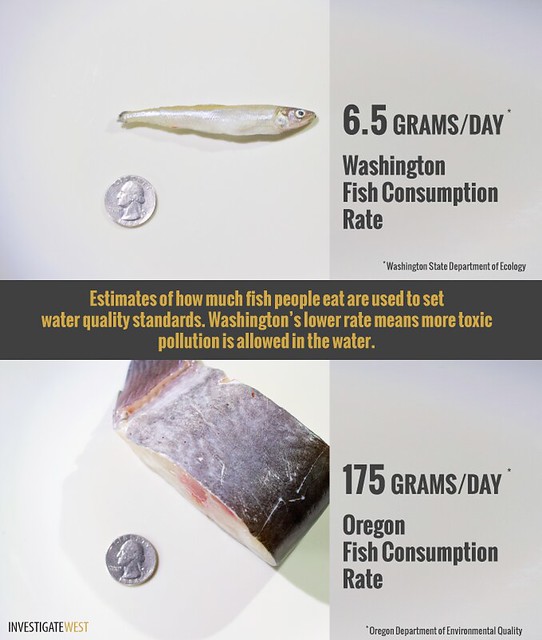Here’s the scenario: Washington State, like many states, uses something called fish-consumption rates to set water quality standards. The idea is to start with the average amount of fish people eat, and then figure out how clean the water needs to be in order for someone to eat that amount of fish without putting themselves at risk. If you assume the average consumption rate is very high, then the water needs to be very clean. If you assume a small amount – meh.
So it’s a big deal that Washington is trying to dramatically increase the consumption rate: from 6.5 grams/day to 175 grams. If successful, pollution standards would have to become a lot tougher. It would be a major win for all of us working on health and environmental issues in the Puget Sound region.
 In the coverage last week, reporters have valiantly tried to explain how the policy works: that this is about water quality, not rules about how much fish is safe to eat. It gets confusing. I know the policy better than the average person, and I was still a little confounded by their explanations – until I saw this graphic from Investigate West. Even though it’s over a year old, it does a better job than anything else of articulating exactly what’s at stake. Here’s why:
In the coverage last week, reporters have valiantly tried to explain how the policy works: that this is about water quality, not rules about how much fish is safe to eat. It gets confusing. I know the policy better than the average person, and I was still a little confounded by their explanations – until I saw this graphic from Investigate West. Even though it’s over a year old, it does a better job than anything else of articulating exactly what’s at stake. Here’s why:
- Simplicity. Your eye is immediately drawn to the two central images: the tiny fish and the chunk of fish.
- Contrast. Setting the pictures alongside one another shows you immediately that the current standard doesn’t pass the laugh test. The quarter for scale is a nice touch.
- Values first. While not everyone eats fish out of Puget Sound or its tributaries, everyone cares about clean water. The copy immediately establishes that the issue at play is water quality.
- A clear threat. While the problem is already inferred, the second sentence brings home the message that Washington’s standard isn’t just silly, it allows more pollution.
While I love the simplicity of the graphic, I think it could have been even more effective if it visually connected water quality and fish consumption to human health. A punchy headline, too, would help tell the story and would likely make the entire image more shareable via digital and social media channels.
